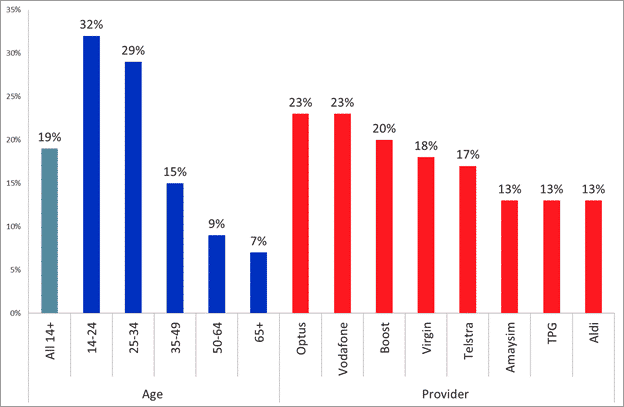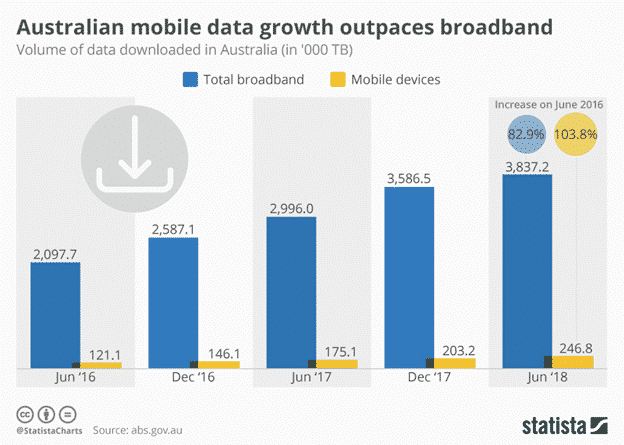Nearly 19% of Australians exceed their data limit on a regular basis
Research by Roy Morgan indicates that almost one third of smartphone users aged 14-24 and almost as many aged 25-34 finish their data allowance too soon. This tendency to go over the data cap drops among smartphone users aged 35-49 and continues to decline with age.
Younger smartphone users who are aged between 14 and 34 are more than eight times more likely than those aged 50 or above to be streaming music or video on their devices. This data-rich content means that Australians often exceed their data limit.
Smartphone users by age and provider, exceeding the data limit. Source
Another 2018 survey shows that Aussies are charged approximately $181 million for extra mobile data usage per year. Exceeding the data limit not only costs Australians extra money on top of their regular plan, but it also creates data overload for network providers.
What is data overload?
Mobile phone companies are already struggling to meet the increasing need for data on smartphones, which creates an overloaded system and can result in reduced speeds across the board. Even the major networks like Telstra and Vodafone see data overload on their network. Most of the major network providers have responded to increased demand for data movement and network capacity by improving infrastructure and looking forward to 5G. However, that means that these companies are charging customers a higher amount for extra data once they go over their allotted amount as a way to profit from this overload.
Ways to reduce data usage
The volume of data used by smartphones increased by 103.8 percent from June 2016 to June 2018, outpacing total broadband data volumes.
In Australia, mobile data growth outpaces broadband. Source
Along with this major increase in data consumption, the number of mobile subscriptions is also climbing, and will reach 26.98 million subscriptions in June 2018.
Fortunately, there are several ways to monitor your mobile data usage so that you can control and reduce it accordingly. But for this, you have first to understand your monthly data usage pattern. You can find out how you use your data in the following ways:
- Monitor your data usage via your phone settings
Whether you own an Android device or an iOS mobile phone, you can utilize inbuilt functions to see how much data you have used. You can also check how much data every app on your smartphone is consuming.
If you own an Android phone, go to ‘Wireless and networks’ in the Settings menu. Then, click on “Data Usage” to find both cellular data and Wi-Fi data usage. However, you’ll have to check whether your phone matches the same billing period as your phone provider to get accurate results. To fix this, navigate to the “Billing Cycle” tab and set the beginning date for the same date your plan provider starts a new billing period.
If you are using an iOS device, tap “Cellular” in the Settings menu. Now, scroll down to the “Cellular Data Usage” to find how much mobile data you are consuming.
- Use your carrier’s data usage tool
Network providers such as Telstra, Optus, and Vodafone provide their customers with tools that allow them to monitor mobile data usage over the billing period, and even look back on past bills. You can find these tools on the official website of your carrier, or they should have the option of an app that you can download from your app store.
- Use a third party data usage tracking app
You can also use a third-party internet mobile data management app. Some of the most recommended apps are My Data Manager by Mobidia Technology, Internet Speed Meter Lite by DynamicApps and Mobile Data Usage developed by Gibli Mobile, to name a few. Simply download the app on your mobile, create your account, and monitor your mobile data usage.
- Choosing an internet plan according to your data needs
Once you know your data usage pattern and your data needs, you can choose an appropriate plan that accommodates your data usage habits.
Monitoring your data should take a lot of factors into consideration, such as the type of smartphone, time of internet use, location, and what the data is spent on. The content type affects your data usage, and most smartphone users today spend their mobile data on video and music streaming. Australia ranks number six in terms of video streaming rate, after the United State, Canada, Norway, Sweden, and Finland.
Your phone’s hardware features and quality of processor are critical factors determining the amount of data you will require. The faster processor can better deal with the data traffic. This means if you own a new iPhone 8 and live in a 4G coverage area, you will consume more data than a user who owns an iPhone 5, which doesn’t have a faster process than that of iPhone 8.
- Keeping Control
The way we use data is changing, and phone companies are counting on customers to exceed their data limits so that they can charge an extra fee. The best way to avoid going over your allocated data is to be conscious of how much you use, tracking your usage and identifying data usage habits that may be using more data than necessary. Small changes like downloading movies at home instead of relying on mobile data, or waiting until there is a Wi-Fi connection to browse social media could be the change you need to make sure you avoid all future excess usage fees, and avoid exceeding your data limits for good.

